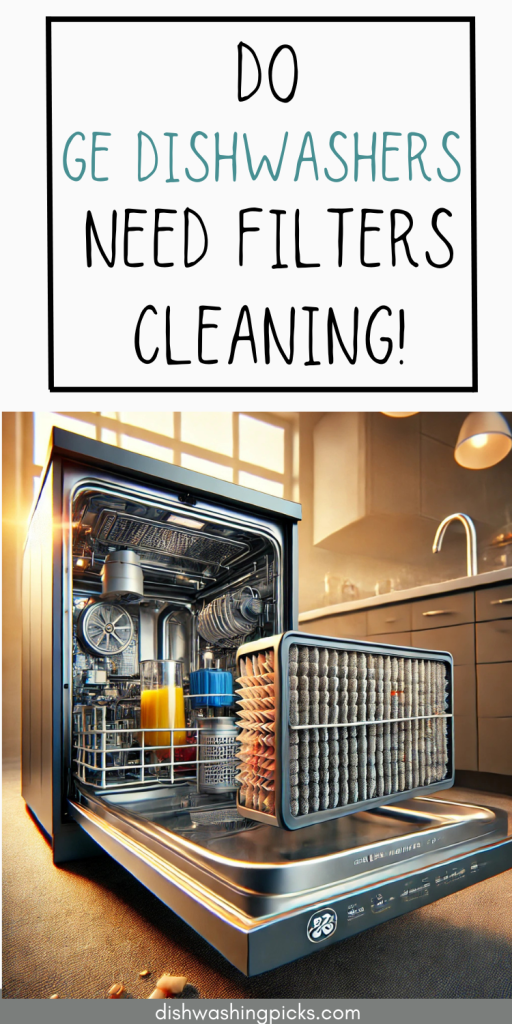
Picture this: You open your dishwasher, expecting sparkling clean dishes, but instead, you’re greeted with cloudy glasses and food residue stuck to your plates. Annoying, right? You might be thinking, “Did I forget to add detergent? Did I overload it? Is my dishwasher just… broken?”
Hold up! Before you start blaming the dishwasher (or yourself), there’s a sneaky culprit that most people overlook—the filter. Yes, that little part hiding at the bottom of your GE dishwasher could be the reason your dishes aren’t getting as clean as they should. But here’s the big question: Does it actually need cleaning? Or is it one of those unnecessary chores that appliance manufacturers scare us into doing?
Let’s break it down.
What Does the Filter Even Do?
Alright, let’s get one thing straight—your dishwasher isn’t just a magical box that makes dirty dishes sparkle. There’s a lot going on behind the scenes, and your filter plays a crucial role. Think of it as your dishwasher’s bouncer, standing at the entrance of the drain, deciding what gets through and what stays behind.
Its job? Catching food particles, grease, and gunk so they don’t end up clogging your dishwasher or redepositing onto your supposedly “clean” dishes. Without it, you’d have a mini food compost heap swirling around every time you run a cycle. Yikes.
Now, here’s the thing—not all dishwasher filters are created equal. Some are self-cleaning (more on that in a sec), while others need a little TLC from time to time. So where does your GE dishwasher stand?
Do GE Dishwashers Have Self-Cleaning Filters?
Ah, the dream—a filter that cleans itself so you don’t have to. Some dishwashers, especially older models, used grinders (basically mini garbage disposals) to break down food bits and flush them away. But guess what? Many modern GE dishwashers ditched the grinder in favor of a removable filter that requires manual cleaning.
Why the switch? Two reasons:
- Noise Levels – The grinding mechanism was loud, and no one likes their dishwasher sounding like a rock tumbler.
- Energy Efficiency – Manual filters save power, making dishwashers more eco-friendly.
So if you own a newer GE dishwasher, chances are you’ll need to clean the filter yourself—but don’t worry, it’s easier than you think.
How Often Should You Clean Your GE Dishwasher Filter?
Okay, so we’ve established that your GE dishwasher probably has a filter that needs cleaning. But how often should you actually do it? Well, it depends on how you use your dishwasher:
- If you pre-rinse your dishes like a perfectionist – You can get away with cleaning your filter once every 6 months.
- If you scrape but don’t rinse – Aim for once a month to prevent buildup.
- If you toss in dishes with food still stuck on them – You should check your filter every two weeks (sorry, but that pasta sauce isn’t going to disappear on its own).
A good rule of thumb? If your dishwasher starts smelling funky or your dishes come out dirty, it’s time for a filter check.
How to Clean Your GE Dishwasher Filter in 5 Minutes (No Fancy Tools Needed!)
Alright, time to roll up those sleeves (don’t worry, you won’t get too messy). Cleaning your GE dishwasher filter is ridiculously easy—no special tools, no scrubbing until your arms give out. Here’s how to do it in five simple steps.
Step 1: Locate the Filter
First things first—find the filter. In most GE dishwashers, it’s at the bottom of the tub, right under the lower spray arm. You might have to remove the bottom rack to see it clearly.
Step 2: Remove the Filter
Gently twist the filter counterclockwise (usually a quarter-turn) and lift it out. Some models have an extra mesh screen underneath—if yours does, pull that out too.
Step 3: Rinse Off the Gunk
Take the filter to your sink and rinse it under warm running water. This should remove most of the food debris and grease. If you see any stubborn grime stuck in the mesh, grab a soft toothbrush and give it a light scrub.
🚫 Avoid using harsh chemicals or scouring pads—you don’t want to damage the fine mesh.
Step 4: Check the Drain Area
Before putting the filter back, take a quick peek at the drain opening in your dishwasher. If you see any chunks of food, wipe them out with a damp paper towel. This will prevent clogs and keep things running smoothly.
Step 5: Reinstall the Filter
Pop the filter back into place, twist it clockwise until it locks, and you’re done. Easy, right?
Bonus Tips to Keep Your Dishwasher Running Like a Pro
Now that your filter is sparkling clean, here are a few extra tricks to keep your GE dishwasher in top shape:
✅ Run vinegar through it – Once a month, place a cup of white vinegar on the top rack and run a hot cycle to break down grease and mineral buildup.
✅ Use the right detergent – Stick with high-quality dishwasher detergent and avoid overloading the dispenser (too much soap = residue).
✅ Scrape, don’t rinse – A quick scrape removes large food chunks, but don’t over-rinse—dishwashers actually clean better when they have a little food residue to work with!
✅ Check spray arms – Every so often, spin the spray arms to make sure they move freely, and use a toothpick to clear out any clogged holes.
Final Verdict: Do GE Dishwashers Need Filter Cleaning?
Absolutely. If your GE dishwasher has a removable filter, it needs regular cleaning to keep it running efficiently. A clogged filter can lead to dirty dishes, bad smells, and even drainage issues. But the good news? It’s a super easy task that takes just a few minutes.
So, next time your dishwasher starts acting up, don’t panic—just check the filter. A little maintenance goes a long way!
